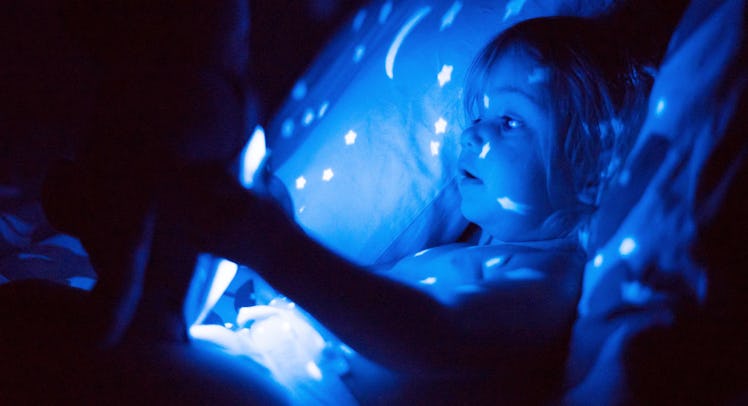What Is ‘Blue Light’ And How Is It Messing With Your Kid’s Sleep?
Don't let the light in.

Light is, by all accounts, pretty great. It provides humans with Vitamin D, prevents you from tripping over things constantly, and keeps a body running as it should. As you may have heard, blue light cast by electronic devices is the worst. Whether it’s you Instagramming until 2AM or your preschooler logging in a few more minutes of iPad before bedtime, this particular light wavelength is an a-hole for everyone’s sleep. But, particularly for your kids.
Why, exactly? Well, Lameese D. Akacem, a leading sleep-researcher and chronobiologist at Chicago’s Rush University Medical Center, says artificial blue light basically triggers your body to think it’s time to be awake when it’s time to sleep. And because kids’ eyes are still-developing things, they’re more vulnerable to its effects. Here’s what she has to say about blue light, bedtime, and what you can do to safeguard the sleep cycle of those who need it more than you.
The Light That Guides Us
You’re biologically wired to wind down in the dark. Darkness triggers cells in your eye, those tell your circadian clock that it’s time for bed, and that releases the sleep hormone melatonin. It’s like a game of nightly telephone. But light tells the circadian clock to suppress it so you can be up and at ’em.
Over the course of the day, natural light changes: morning light is dense with blue light (it’s designed to wake you up) whereas afternoon light is warmer-hued and longer in wavelength (it slowly triggers your body to become sleepy). This natural order of things make sense. But, when you and the kids are staring at devices at night, the blue light gives your bodies the wrong data to crunch. Your natural rhythms get wonky and your sleep suffers. But here’s the thing: kids suffer more.
Why Kids Might Be More Susceptible To The Blues
A lot of research has looked at how blue light impacts sleep-hormone levels in adults, but children haven’t received as much attention. Akacem studies circadian rhythms in 2-to-5 year olds and believes that young children are more sensitive to the melatonin-suppressing effects of light than adults. Why? For the same reason kids have such expressive faces: Their eyes are huge.
Well, technically, Akacem says your kid’s pupils are proportionately greater, and their peepers have a much clearer lens. Combined, these 2 factors control how much light hits the retina. “The reason why we think kids may be more sensitive is because more light can enter the eye and hit the retina,” she says
In 1 study, Akacem’s team exposed young children to bright light and measured melatonin suppression. The purpose was to show that bright light affects melatonin levels in children more than adults — not just to be jerks. And Japanese researchers tested the effect on kids versus adults, exposing exposed children and their parents to the same light. They saw almost twice as much melatonin suppression in the kids — and probably a ton of spots.
Applying Blue Light Research To Bedtime Rules
So, in terms of salvaging healthy sleep, you should focus on minimizing blue light exposure in the 1 or 2 hours before bed, with a longer low-light period for young children. If you can’t make that happen, then here are some other steps you can take:
- Set Their Screens On A Dimmer: There’s a handful of software and apps that let you sync a screen’s glow with the sun’s daily patterns, making your computer brighter in the morning and dimmer at night. This more or less eliminates blue light by bedtime and helps keep your rhythms natural. Some of the best include:
- F.Lux, Free (Mac)(iOS)(Windows)
- NightShift, available with iOS 10 or higher)
- Iris, $2 (Android)(iOS)(Windows)
- Sunset Screen, Free (Windows)
- Lux, Free (Google Chrome)
- Banish Blue Light From Your TV: Everyone talks about computer screens, but the TV is a culprit, too. The Saffron Drift is TV screen-dimming device; with it, you can put your set on a specific schedule, dialing down the amount of blue light it throws out little-by-little.
- Wear A Pair Of Blue Light Blocking Glasses: Yeah, yeah they’ll make you and your family look like a bunch of off-duty shooting range instructors. But, the UVEX Skyper Blue Light Blocking Computer Glasses effectively absorb 98-percent of all blue light. What does that mean? You and the kids can sit and watch TV or play Clash Of Clans without too much worry.
- Go All Pre-Industrial Revolution: Minimize all light exposure in the evening — dim lights, turn off devices, and wind down as though you were born before the age of electricity. This does the best job preventing blue light — or any light — from messing with sleep. Downside? It’ll probably drive you crazy in other ways, and your monthly candle budget just increased 10 fold.
The Safest Time To Bathe In Artificial Blues
You depend on electronics, but they’re slowly sapping you of sleep. So it goes. Scientists, however, are working on better ways of defending you and your family from the light source. Better glasses and better apps come out every day, because they know (and you know) that you’re not going to give up that phone easily.
Akacem is also doing research that determines the time of day a kid’s biological clock is most sensitive electronics and light exposure. All of that that will hopefully make this wavelength manageable. Right now, just know that midday has the least costly effect. Lunchtime Candy Crush?
This article was originally published on